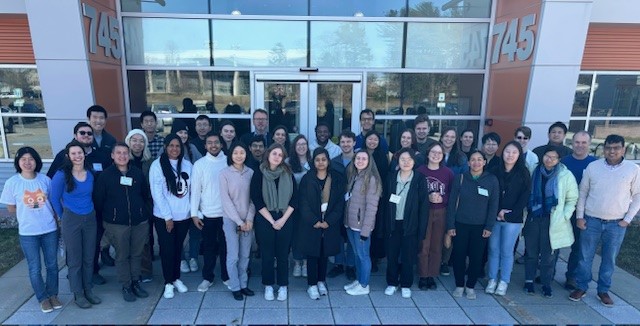March 19-21, 2024#
TL;DR
Download all slide decks and other course materials:
March2024.zip
X-ray absorption spectroscopy is a core technique of the DOE synchrotron user facilities and attracts diverse scientific communities. This 3-day course offered by NSLS-II experts introduced XAS data analysis to new and prospective users and provided an opportunity to participate in measurements at NSLS-II XAS beamlines. The first two days were devoted to the fundamentals of XAS analysis, data reduction and processing, and the basics of XAS experiments and instrumentation.
Participants were trained on XAS data analysis of increasing complexity. Modern XAS methods such as high-resolution spectroscopy were be introduced. On the third day, the participants participated in experiments at the three XAS beamlines.
This course was organized and presented by Lu Ma, Bruce Ravel, and Eli Stavitski with additional lectures by Denis Leshchev and Akhil Tayal and help from Dali Yang. Kerri Banaszek provided logistical support.

Fig. 2 The participants and instructors of the March 2024 XAS Workshop#
Tuesday, March 19#
- Welcome:
A greeting from the NSLS-II interim director and an overview of the scientific mission of the light source
Presenter: Erik Johnson
Slide deck:
BNL NSLS-II XAS 19 MAR 2024.pdf
- Introduction to XAS:
Overview of the basic physics and chemistry of XAS
Presenter: Bruce Ravel
Slide deck:
XAFS2024_Intro.pdf
- Data reduction and background removal:
An introduction to processing XAS data, including background subtraction and Fourier transforms
Presenter: Akhil Tayal
Slide deck:
XAFS_Normalization_2024.pdf
- EXAFS analysis I:
An introductory EXAFS data analysis problem using FeS2. This is the introduction to fitting EXAFS data analysis with Feff and Artemis
Presenter: Bruce Ravel
μ(E) data:
FeS2_RT.xmucrystal data:
FeS2.inp(this is a file format that Artemis can inport)final fitting model:
FeS2_final.fpjdiscussion of FeS2 final fit:
fes2.pdf
- XANES analysis:
An introduction to methods and challenges of XANES analysis.
Presenter: Denis Leshchev
Slide deck:
XANES_analysis_workshop.pdf
Wednesday, March 20#
- Sample preparation and sample environments:
A discussion of how to plan for your XAS experiment, how to prepare your samples for measurement, and how to plan for in situ and operando experiments
Presenter: Eli Stavitski
Slide deck:
Sample_prep_and_sample_environemnts_2024.pdf
- EXAFS analysis II:
The FeS2 example from the previous day might seem a bit too simple. It involves analysis of a crystalline material, thus the path through the analysis obviously starts with crystal data. In these two lectures, some ideas are presented about how to perform EXAFS analysis on more complex materials.
Presenter: Bruce Ravel
EXAFS and non-crystalline materials:
noxtal.pdfA hard EXAFS problem, Hg bound to nucleotides:
hgdna.pdf
- High energy resolution techniques:
High energy resolution fluorescence detection (HERFD), X-ray emission spectroscopy (XES), and resonant inelastic X-ray spectroscopy (RIXS) using crystal spectrometers.
Presenter: Denis Leshchev
Slide deck:
High_resolution_techniques_workshop.pdf
- Combined techniques:
How to plan for and implement additional measurement techniques such as XRD and DRIFTS during your XAS experiment.
Presenter: Lu Ma
Slide deck:
LM-XAS2024-1.pdf
Thursday, March 21#
- Experimental session:
Hands-on XAS data collection at the NSLS-II hard X-ray spectroscopy beamlines
Data from QAS#
Coming soon
Data from QAS
Data from BMM#
During the hands-on experiment at BMM in the morning, we measured several Mn standards along with the mineral babingtonite in fluorescence at the Mn and Fe edges.
In the afternoon, we measured several Zn standards along with the mineral petedunnite in fluorescence at the Zn and Fe edges.
Zip file containing these data and the full electronic log book:
BMM data.zip
ISS exercise: Understanding experimental artifacts#
Coming soon
Presentation by Eli
Links and Resources#
Here is a zip file with all of the downloads linked above:
March2024.zip